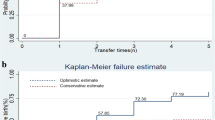Abstract
Background
Despite many advances, patients with a poor ovarian response to stimulation are one of the most important and challenging factors of infertility. Chronological and ovarian ages are two effective factors responsible for poor response to assisted reproduction treatment. The purpose of this study was to determine the effect of age and AMH level on the in vitro fertilization (IVF) outcomes in participants with a reduced ovarian reserve.
Methods
In this retrospective cross-sectional study, 210 participants with anti-Mullerian hormone (AMH) < 1.1 ng/ml were included. The effect of age and AMH on pregnancy outcomes including dominant follicle count, serum estradiol level on the day of trigger administration, number of metaphase II (MII) oocytes, number of embryos, biochemical pregnancy, clinical pregnancy, abortion and live birth rate were evaluated.
Results
The number of dominant follicle (p < 0.001), MII oocyte (p < 0.001), grade A (p < 0.001) and B (p < 0.001) embryos, serum estradiol level (p < 0.001), gonadotropin level ( p< 0.001), AMH (p = 0.001), biochemical pregnancy (p = 0.007), clinical (p = 0.01) pregnancy, and live birth rate (p = 0.003) were higher in participants younger than 35 years old. In univariable logistic regression, the chance of retrieving more than 3 oocytes in individuals over 35 years old was 97.1% lower than in individuals younger than 35 years old (p < 0.001).
Conclusion
It has been concluded that the higher clinical pregnancy and live birth rate in participants younger than 35 years can be due to the higher AMH level in this group. Under the same conditions of AMH and other variables, age can affect the number of retrieved oocytes.
Similar content being viewed by others
References
Hosein Rashidi B, Kabodmehri R, Shariat M, et al. Luteinizing hormone changes in gonadotropin-releasing hormone antagonist protocol in in vitro fertilization cycles: A cross-sectional study. Int J Reprod Biomed. 2019;17:209–16.
Giovanale V, Pulcinelli FM, Ralli E, et al. Poor responders in IVF: an update in therapy. Gynecol Endocrinol. 2015;31:253–7.
Drakopoulos P, Bardhi E, Boudry L, et al. Update on the management of poor ovarian response in IVF: the shift from Bologna criteria to the Poseidon concept. Ther Adv Reprod Heal. 2020;14:2633494120941480.
Amanvermez R, Tosun M. An update on ovarian aging and ovarian reserve tests. Int J Fertil Steril. 2016;9(4):411–5.
Eftekhar M, Aflatoonian A, Mohammadian F, et al. Adjuvant growth hormone therapy in antagonist protocol in poor responders undergoing assisted reproductive technology. Arch Gynecol Obstet. 2013;287:1017–21.
Fritz R, Jindal S. Reproductive aging and elective fertility preservation. J Ovarian Res. BioMed Central. 2018; 11(1):66.
Morin SJ, Patounakis G, Juneau CR, et al. Diminished ovarian reserve and poor response to stimulation in patients< 38 years old: a quantitative but not qualitative reduction in performance. Hum Reprod. 2018;33:1489–98.
Ford EA, Beckett EL, Roman SD, et al. Advances in human primordial follicle activation and premature ovarian insufficiency. Reproduction. 2020; 159(1):R15–R29.
Steiner AZ, Herring AH, Kesner JS, et al. Antimüllerian hormone as a predictor of natural fecundability in women aged 30–42 years. Obstet Gynecol. 2011;117.
Scheffer JAB, Scheffer B, Scheffer R, et al. Are age and anti-Müllerian hormone good predictors of ovarian reserve and response in women undergoing IVF? JBRA Assist Reprod; 2018; 22(3):215–20.
Harris BS, Acharya KS, Truong T, et al. Can a high AMH overcome advancing reproductive age? the association between AMH and live birth rate among women over age 40. Fertil Steril. 2018;110:e109.
Massarotti C, La Pica V, Sozzi F, et al. Influence of age on response to controlled ovarian stimulation in women with low levels of serum anti-Müllerian hormone. Gynecol Endocrinol. 2020;36:1074–8.
Honnma H, Baba T, Sasaki M, et al. Different ovarian response by age in an anti-Müllerian hormone-matched group undergoing in vitro fertilization. J Assist Reprod Genet. 2012;29:117–25.
Gizzo S, Andrisani A, Esposito F, et al. Ovarian reserve test: an impartial means to resolve the mismatch between chronological and biological age in the assessment of female reproductive chances. Reprod Sci. 2014;21:632–9.
Tarasconi B, Tadros T, Ayoubi J-M, et al. Serum antimüllerian hormone levels are independently related to miscarriage rates after in vitro fertilization–embryo transfer. Fertil Steril. 2017;108:518–24.
Merhi Z, Zapantis A, Berger DS, et al. Determining an anti-Mullerian hormone cutoff level to predict clinical pregnancy following in vitro fertilization in women with severely diminished ovarian reserve. J Assist Reprod Genet. 2013;30:1361–5.
Acknowledgments
The authors would like to thank the members of the Reproductive Health Research Center of Guilan University of Medical Sciences for their constant support.
Funding
This work was supported by Guilan University of Medical Sciences.
Author information
Authors and Affiliations
Contributions
FH, RK., ZZS; Contributed to conception and design, data collection; NGG, and SH; Drafted the manuscript, which was revised by MM, and MMG; MG; statistical analysis; All authors read and approved the final manuscript.
Corresponding author
Ethics declarations
Conflict of interest
The authors declare that they have no conflict of interest.
Ethical Approval
Ethical approval was obtained from the ethics committee of Guilan University of Medical Sciences (approval id: IR.GUMS.REC.1399.130).
Informed consent
Informed consent was taken from all participants.
Human Participants
This research involved human participants. Ethical approval was obtained from the Ethics Committee of Guilan University of Medical Sciences (Approval ID: IR.GUMS.REC.1399.130). Informed consent has been obtained from all participants in adherence to the Declaration of Helsinki.
Additional information
Publisher's Note
Springer Nature remains neutral with regard to jurisdictional claims in published maps and institutional affiliations.
Rights and permissions
About this article
Cite this article
Hosseinzadeh, F., Kabodmehri, R., Mehrafza, M. et al. The Effect of Age and AMH Level on ART Outcomes in Patients With Reduced Ovarian Reserve: A Retrospective Cross-Sectional Study. J Obstet Gynecol India 72, 420–425 (2022). https://doi.org/10.1007/s13224-021-01582-y
Received:
Accepted:
Published:
Issue Date:
DOI: https://doi.org/10.1007/s13224-021-01582-y




